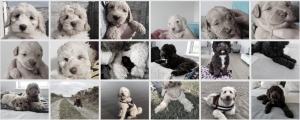Health Testing Information about Labradoodles
Read About General Health Testing And Our Policies.
Health
Labradoodles can suffer from problems common to their parent breeds. Poodles and Labrador Retrievers can suffer from hip dysplasia, and should have specialist radiography to check for this problem before breeding. The parent breeds can also suffer from a number of eye disorders, and an examination by a qualified veterinary eye specialist should be performed on breeding dogs.
Labradoodles have been known to suffer from progressive retinal atrophy (PRA), an inherited disease causing blindness, which occurs in both Miniature Poodles and Cocker Spaniels. It is recommended that Australian Labradoodles be DNA tested for PRA before being bred.
One study has found that UK Labradoodles have a higher incidence (4.6%) of multifocal retinal dysplasia (MRA) compared to Labrador Retrievers. Cataract is common as well (3.7%) but prevalence is comparable to that of Labradors.
Lifestyle Needs
The name ‘Labradoodle’ is given to a cross between a Poodle and Labrador (so is not a breed in the accepted sense). This is usually a Standard Poodle but smaller Poodles are sometimes used to breed a smaller dog. Generally Labradoodles are largish dogs. The offspring of such a mating is known as an F1 cross and may have the added benefit of heterosis (or ‘hybrid vigor’). If two Labradoodles are mated together, this is known as F2. An F2 bred to an F2 will result in an F3, and so on. If an F1 is bred back to either parent breed it is an F1B.
Temperament will vary but typically, if well socialised as puppies, the labradoodle will be a lively, good natured family pet. There is the potential for owners to be less likely to be allergic to these dogs, but zero or low allergy is not guaranteed even within the same litter. It is claimed that these dogs will not shed their coats but this is not guaranteed. Coat type is varied. These large dogs will need plenty of exercise and stimulation, with regular opportunities to walk off lead. Regular, frequent and thorough grooming is needed.
Inbreeding coefficient – COI
(should be as low as possible and not higher than 6%)
An F1 Labradodle’s COI will be 0%
F1B (an F1 bred back to either breed) should be no higher that 6.25% (ensuring no common ancestry within great grandparents, or third generation)
F2, F3, F4 should be no higher that 6.25% (using CCGB Club registration papers showing no common ancestry on 3 generation lineage record)
Health and welfare problems due to conformation
(body shape and physical characteristics)
The Labradoodle is free from exaggerations but the coat could be a problem if it is not kept clean and tangle free. If allowed to get tangled and matted, dirt and dust would collect and may lead to skin problems.
BVA/KC Health Schemes
Elbow dysplasia: (malformation of the elbow joint causing pain and disability) score should be as low as possible
Eye disease: Progressive retinal atrophy (gradual loss of vision); Hereditary cataract; Multifocal retinal dysplasia (MRD)
Hip dysplasia: (malformation of the hip joint causing pain and disability) breed mean score (Poodle) 14; breed mean score (Labrador) 14; breed mean score (Labradoodle) 13 Both parents should be lower

